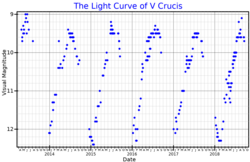| The topic of this article may not meet Misplaced Pages's general notability guideline. Please help to demonstrate the notability of the topic by citing reliable secondary sources that are independent of the topic and provide significant coverage of it beyond a mere trivial mention. If notability cannot be shown, the article is likely to be merged, redirected, or deleted. Find sources: "V Crucis" – news · newspapers · books · scholar · JSTOR (May 2021) (Learn how and when to remove this message) |
 The visual band light curve of V Crucis, from AAVSO data | |
| Observation data Epoch J2000.0 Equinox J2000.0 | |
|---|---|
| Constellation | Crux |
| Right ascension | 12 56 35.559 |
| Declination | −57° 53′ 57.02″ |
| Apparent magnitude (V) | 8.74 - 11.13 |
| Characteristics | |
| Spectral type | Ce(Ne) |
| Variable type | Mira |
| Astrometry | |
| Radial velocity (Rv) | −19.90 km/s |
| Proper motion (μ) | RA: 0.507 mas/yr Dec.: 1.989 mas/yr |
| Parallax (π) | 0.7451 ± 0.0475 mas |
| Distance | 4,400 ± 300 ly (1,340 ± 90 pc) |
| Absolute magnitude (MV) | -4.67 |
| Details | |
| Radius | 130 R☉ |
| Luminosity | 7,244 L☉ |
| Temperature | 3,075 K |
| Other designations | |
| V Cru, CD−57°4791, HD 112319, HIP 63175, IRAS 12536-5737, 2MASS J12563556-5753569 | |
| Database references | |
| SIMBAD | data |
V Crucis is a carbon star in the constellation Crux. A Mira variable, its apparent magnitude ranges from 8.7 to 11.1 over 376.5 days. The fact that this star's period is nearly equal to one year makes it hard to get good observational coverage over the entire cycle. Its near-infrared light curve shows a contribution from the first harmonic of the fundamental period.
References
- "Download Data". aavso.org. AAVSO. Retrieved 1 October 2021.
- ^ Brown, A. G. A.; et al. (Gaia collaboration) (August 2018). "Gaia Data Release 2: Summary of the contents and survey properties". Astronomy & Astrophysics. 616. A1. arXiv:1804.09365. Bibcode:2018A&A...616A...1G. doi:10.1051/0004-6361/201833051. Gaia DR2 record for this source at VizieR.
- Pojmanski, G. (2002). "The All Sky Automated Survey. Catalog of Variable Stars. I. 0 h - 6 hQuarter of the Southern Hemisphere". Acta Astronomica. 52: 397–427. arXiv:astro-ph/0210283. Bibcode:2002AcA....52..397P.
- ^ "V Crucis". AAVSO Website. American Association of Variable Star Observers. 4 January 2010. Retrieved 2019-12-11.
- Gontcharov, G. A. (2006). "Pulkovo Compilation of Radial Velocities for 35 495 Hipparcos stars in a common system". Astronomy Letters. 32 (11): 759–771. arXiv:1606.08053. Bibcode:2006AstL...32..759G. doi:10.1134/S1063773706110065. S2CID 119231169.
- Guandalini, R.; Cristallo, S. (2013). "Luminosities of carbon-rich asymptotic giant branch stars in the Milky Way". Astronomy and Astrophysics. 555: A120. arXiv:1305.4203. Bibcode:2013A&A...555A.120G. doi:10.1051/0004-6361/201321225. S2CID 54918450.
- ^ Bergeat, J.; Knapik, A.; Rutily, B. (2002). "Carbon-rich giants in the HR diagram and their luminosity function". Astronomy and Astrophysics. 390 (3): 967–986. Bibcode:2002A&A...390..967B. doi:10.1051/0004-6361:20020525.
- "V Cru". SIMBAD. Centre de données astronomiques de Strasbourg. Retrieved 2019-12-11.
- Whitelock, P. A.; Feast, M. W.; Marang, F.; Overbeek, M. D. (June 1997). "Mass-loss variations among carbon-rich AGB variables". Monthly Notices of the Royal Astronomical Society. 288 (2): 512–532. Bibcode:1997MNRAS.288..512W. doi:10.1093/mnras/288.2.512.
| Constellation of Crux | |||||||||||
|---|---|---|---|---|---|---|---|---|---|---|---|
| Stars |
| ||||||||||
| |||||||||||
| |||||||||||
| |||||||||||
This variable star–related article is a stub. You can help Misplaced Pages by expanding it. |